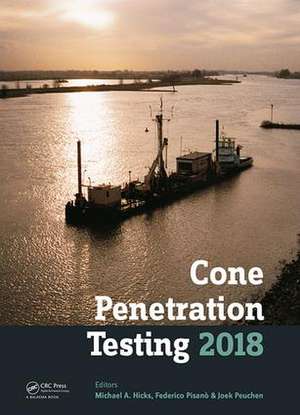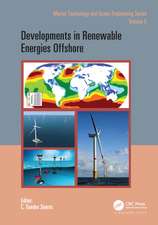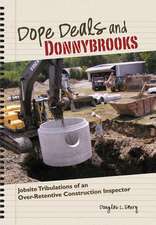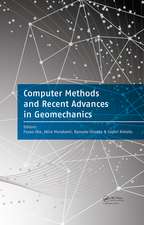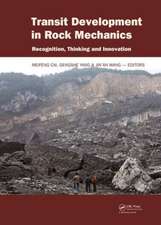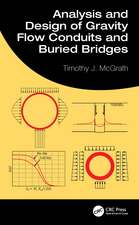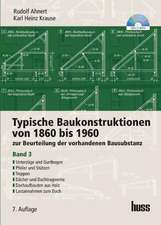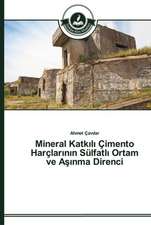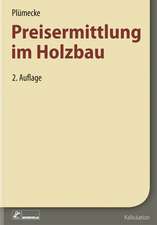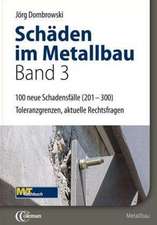Cone Penetration Testing 2018: Proceedings of the 4th International Symposium on Cone Penetration Testing (CPT'18), 21-22 June, 2018, Delft, The Netherlands
Editat de Michael A. Hicks, Federico Pisanò, Joek Peuchenen Limba Engleză Hardback – 5 iun 2018
This is an Open Access ebook, and can be found on www.taylorfrancis.com.
Preț: 1404.86 lei
Preț vechi: 1894.35 lei
-26% Nou
Puncte Express: 2107
Preț estimativ în valută:
268.86€ • 279.65$ • 221.95£
268.86€ • 279.65$ • 221.95£
Carte tipărită la comandă
Livrare economică 14-28 aprilie
Preluare comenzi: 021 569.72.76
Specificații
ISBN-13: 9781138584495
ISBN-10: 1138584495
Pagini: 756
Dimensiuni: 174 x 246 mm
Greutate: 0.48 kg
Ediția:1
Editura: CRC Press
Colecția CRC Press
ISBN-10: 1138584495
Pagini: 756
Dimensiuni: 174 x 246 mm
Greutate: 0.48 kg
Ediția:1
Editura: CRC Press
Colecția CRC Press
Public țintă
Postgraduate and ProfessionalCuprins
Keynote papers Penetrometer equipment and testing techniques for offshore design of foundations, anchors and pipelines M.F. Randolph et al. Inverse filtering procedure to correct cone penetration data for thin-layer and transition effects R.W. Boulanger and J.T. DeJong Use of CPT for the design of shallow and deep foundations on sand K.G. Gavin CPT'18 papers Evaluating undrained rigidity index of clays from piezocone data S.S. Agaiby and P.W. Mayne On the use of CPT for the geotechnical characterization of a normally consolidated alluvial clay in Hull, UK L. Allievi et al. New vibratory cone penetration device for in-situ measurement of cyclic softening D. Al-Sammarraie, S. Kreiter, F.T. Stahler, M. Goodarzi and T. Moerz Estimation of geotechnical parameters by CPTu and DMT data: A case study in Emilia Romagna (Italy) S. Amoroso et al. Cone penetration testing on liquefiable layers identification and liquefaction potential evaluation E. Anamali,et al. Dutch field tests validating the bearing capacity of Fundex piles S. Van Baars, et al. Estimation of spatial variability properties of mine waste dump using CPTu results- case study I. Baginska, M. Kawa and W. Janecki Strength parameters of deltaic soils determined with CPTU, DMT and FVT L. Balachowski, K. Miedlarz and J. Konkol Estimation of the static vertical subgrade reaction modulus ks from CPT N. Barounis and J. Philpot Estimation of in-situ water content and void ratio using CPT for saturated sands N. Barounis and J. Philpot NMO-SCTT: A unique SCPT tomographic imaging algorithm E. Baziw and G. Verbeek Effect of piezocone penetration rate on the classification of Norwegian silt A. Bihs et al. Quantifying the effect of wave action on seabed surface sediment strength using a portable free fall penetrometer C. Bilici et al. Interpretation of seismic piezocone penetration test and advanced laboratory testing for a deep marine clay M.D. Boone et al. CPT-based liquefaction assessment of CentrePort Wellington after the 2016 Kaikoura earthquake J.D. Bray et al. Use of CPTu for design, monitoring and quality assurance of DC/DR ground improvement projects A. Brik and P.K. Robertson Cost effective ground improvement solution for large scale infrastructure project A. Brik and D. Tonks Evaluation of existing CPTu-based correlations for the deformation properties of Finnish soft clays B. Di Buo et al. Ultimate capacity of the drilled shaft from CPTu test and static load test M.A. Camacho et al. Interpreting properties of glacial till from CPT and its accuracy in determining soil behaviour type when applying it to pile driveability assessments A. Cardoso et al. Variable rate of penetration and dissipation test results in a natural silty soil R. Carroll and P. Paniagua Rapid penetration of piezocones in sand S.H. Chow, B. Bienen and M.F. Randolph Applying Bayesian updating to CPT data analysis S. Collico et al. Geotechnical characterization of a very soft clay deposit in a stretch of road works R.Q. Coutinho, H.T. Barbosa and A.D. Gusmao Analysis of drainage conditions for intermediate soils from the piezocone tests R.Q. Coutinho and F.C. Mellia Behaviour of granitic residual soils assessed by SCPTu and other in-situ tests N. Cruz et al. Rate effect of piezocone testing in two soft clays F.A.B. Danziger et al. A modified CPT based installation torque prediction for large screw piles in sand C. Davidson et al. Effects of clay fraction and roughness on tension capacity of displacement piles L.V. Doan and B.M. Lehane Shaft resistance of non-displacement piles in normally consolidated clay L.V. Doan and B.M. Lehane Effects of partial drainage on the assessment of the soil behaviour type using the CPT L.V. Doan and B.M. Lehane Analysis of CPTU data for the geotechnical characterization of intermediate sediments M.F. Garcia Martinez et al. Detection of soil variability using CPTs T. de Gast, P.J. Vardon and M.A. Hicks MPM simulation of CPT and model calibration by inverse analysis P. Ghasemi et al. Challenges in marine seismic cone penetration testing P. Gibbs et al. Numerical simulation of cone penetration test in a small-volume calibration chamber: The effect of boundary conditions M. Goodarzi et al. Transition- and thin layer corrections for CPT based liquefaction analysis J. de Greef and H.J. Lengkeek Soil classification of NGTS sand site (Oysand, Norway) based on CPTU, DMT and aboratory results A.S. Gundersen et al. Numerical study of anisotropic permeability effects on undrained CPTu penetration L. Hauser et al. Evaluating undrained shear strength for peat in Hokkaido from CPT H. Hayashi and T. Yamanashi Interpreting improved geotechnical properties from RCPTUs in KCl-treated quick clays T.E. Helle, M. Long and S. Nordal Some experiences using the piezocone in Mexico E. Ibarra-Razo et al. Evaluation of complex and/or short CPTu dissipation tests E. Imre et al. New Russian standard CPT application for soil foundation control on permafrost O.N. Isaev et al. Thermophysical finite element analysis of thawing of frozen soil by means of HT-CPT cone penetrometer O.N. Isaev, R.F. Sharafutdinov and D.S. Zakatov Large deformation modelling of CPT probing in soft soil-pore water pressure analysis J. Konkol and L. Balachowski The use of neural networks to develop CPT correlations for soils in northern Croatia M.S. Kovacevic et al. CPT in thinly inter-layered soils D.A. de Lange, J. Terwindt and T.I. van der Linden CPT based unit weight estimation extended to soft organic soils and peat H.J. Lengkeek, J. de Greef and S. Joosten Impact of sample quality on CPTU correlations in clay-example from the Rakkestad clay J.S. L'Heureux et al. Use of the free fall cone penetrometer (FF-CPTU) in offshore landslide hazard assessment J.S. L'Heureux et al. Fibre optic cone penetrometer P. Looijen et al. Some considerations related to the interpretation of cone penetration tests in sulphide clays in eastern Sweden A.B. Lundberg and E.A. Alderlieste Effect of cone penetrometer type on CPTU results at a soft clay test site in Norway T. Lunne et al. Evaluation of CPTU Nkt cone factor for undrained strength of clays P.W. Mayne and J. Peuchen Applying breakage mechanics theory to estimate bearing capacity from CPT in polar snow A.B. McCallum Empirical correlations to improve the use of mechanical CPT in the liquefaction potential evaluation and soil profile reconstruction C. Meisina, S. Stacul & D.C. Lo Presti Rigidity index (IR) of soils of various origin from CPTU and SDMT tests Z. Mlynarek, J. Wierzbicki and K. Stefaniak A state parameter-based cavity expansion analysis for interpretation of CPT data in sands P.Q. Mo and H.S. Yu Permeability estimates from CPTu: A numerical study L. Monforte, M. Arroyo, A. Gens and C. Parolini Pore pressure measurements using a portable free fall penetrometer M.B. Mumtaz, N. Stark and S. Brizzolara Influence of soil characteristics on cone and ball strength factors: Case studies T.D. Nguyen and S.G. Chung A method for predicting the undrained shear strength from piezocone dissipation test E. Odebrecht, F.M.B. Mantaras and F. Schnaid Realistic numerical simulations of cone penetration with advanced soil models Z.Y. Orazalin and A.J. Whittle Calibrating NTH method for Ï' in clayey soils using centrifuge CPTu Z. Ouyang and P.W. Mayne CPT interpretation and correlations to SPT for near-shore marine Mediterranean soils S. Papamichael and C. Vrettos Characterization of a dense deep offshore sand with CPT and shear wave velocity profiling J.G. Parra, A. Veracoechea and N. Vieira Calibration of cone penetrometers in accredited laboratory J. Peuchen, D. Kaltsas and G. Sinjorgo Defining geotechnical parameters for surface-laid subsea pipe-soil interaction J. Peuchen and Z. Westgate Shallow depth characterisation and stress history assessment of an over-consolidated sand in Cuxhaven, Germany V.S. Quinteros et al. Assessment of pile bearing capacity and load-settlement behavior, based on Cone Loading Test (CLT) results Ph. Reiffsteck, H. van de Graaf and C. Jacquard CPT based settlement prediction of shallow footings on granular soils J. Rindertsma et al. Analysis of acceleration and excess pore pressure data of laboratory impact penetrometer tests in remolded overconsolidated cohesive soils R. Roskoden et al. CPT-based parameters of pile lengths in Russia I.B. Ryzhkov and O.N. Isaev Comparison of settlements obtained from zone load tests and those calculated from CPT and PMT results A. Sbitnev, B. Quandalle and J.D. Redgers Direct use of CPT data for numerical analysis of VHM loading of shallow foundations J.A. Schneider et al. Evaluation of existing CPTu-based correlations for the undrained shear strength of soft Finnish clays J. Selanpaa et al. Applications of RCPTU and SCPTU with other geophysical test methods in geotechnical practice Z. Skutnik, M. Bajda and M. Lech CPT in a tropical collapsible soil C.S.M. Soares et al. Liquefaction resistance by static and vibratory cone penetration tests F.T. Stahler et al. In situ characterisation of gas hydrate-bearing clayey sediments in the Gulf of Guinea F. Taleb, S. Garziglia and N. Sultan Gas effect on CPTu and dissipation test carried out on natural soft-soil of Barcelona Port D. Tarrago and A. Gens Comparison of cavity expansion and material point method for simulation of cone penetration in sand F.S. Tehrani and V. Galavi Soil behavior and pile design: Lesson learned from some prediction events-part 1: Aged and residual soils G. Togliani Soil behavior and pile design: Lesson learned from recent prediction events-part 2: Unusual NC soils G. Togliani A probabilistic approach to CPTU interpretation for regional-scale geotechnical modelling L. Tonni et al. CPTu-based soil behaviour type of low plasticity silts L.A. Torres-Cruz and N. Vermeulen Interpretation of soil stratigraphy and geotechnical parameters from CPTu at Bhola, Bangladesh Z.A. Urmi and M.A. Ansary Thermal Cone Penetration Test (T-CPT) P.J. Vardon, D. Baltoukas and J. Peuchen Development of numerical method for pile design to EC7 using CPT results J.O. Vasconcelos, J. O'Donovan, P. Doherty and S. Donohue Prehistoric landscape mapping along the Scheldt by camera- and conductivity CPT-E J. Verhegge, Ph. Crombe and M. van den Wijngaert Comparative analysis of liquefaction susceptibility assessment by CPTu and SPT tests A. Viana da Fonseca et al. Application of CPT testing in permafrost N.G. Volkov, I.S. Sokolov and R.A. Jewell Comparison of mini CPT cone (2 cm2) vs. normal CPT cone (10 cm2 or 15 cm2) data, 2 case studies G.T. de Vries, C. Laban and E. Bliekendaal The development of "Push-heat", a combined CPT-testing/thermal conductivity measurement system G.T. de Vries and R. Usbeck Free fall penetrometer tests in sand: Determining the equivalent static resistance D.J. White et al. The variability of CPTU results on the AMU-Morasko soft clay test site J. Wierzbicki, R. Radaszewski and M. Walinski Shear strengths determined for soil stability analysis using the digital Icone Vane M. Woollard et al. Metal objects detected and standard parameters measured in a single CPT using the Icone with Magneto click-on module M. Woollard et al. Simulation of liquefaction and consequences of interbedded soil deposits using CPT data F. Yi Correlations among SCPTU parameters of Jiangsu normally consolidated silty clays H. Zou et al.
Notă biografică
Michael Hicks is Professor of Soil Mechanics and Head of Geo-Engineering at Delft University of Technology. He has over 30 years’ experience in finite element analysis, constitutive modelling and soil liquefaction, and has published around 120 articles. His particular interest is the stochastic characterisation and modelling of soil heterogeneity, including its impact on material behaviour and the response of geotechnical structures.
He is a member of the Board of Directors of ALERT Geomaterials and was Chairman of the Organising Committee for Géotechnique’s 2005 Symposium in Print, “Risk and Variability in Geotechnical Engineering.”
He also chaired the International Workshop on “Safety Concepts and Calibration of Partial Factors in European and North American Codes of Practice” (Delft, 2011), the International Conference on “Installation Effects in Geotechnical Engineering” (Rotterdam, 2013), and the 8thEuropean Conference on “Numerical Methods in Geotechnical Engineering” (Delft, 2014).
Federico Pisanò is Assistant Professor of Offshore Soil Mechanics at TU Delft (since 2014) and has 10 years’ experience in the area of theoretical and computational Geomechanics.
He earned a PhD in Geotechnical Engineering in 2011 from Politecnico di Milano and had significant research experiences at international institutions, including Universidad Politecnica de Madrid (2010), University of California Davis (2012-2013) and University of Western Australia (2016). He has published approximately 30 journal and conference papers, with current focus on the numerical analysis of offshore foundations systems and dynamic soil-structure interaction. Since 2015 he is a member of the ISSMGE Technical Committee 209 on Offshore Geotechnics.
Joek Peuchen is a geotechnical engineer at Fugro, Netherlands. He has over 30 years of experience in geotechnical site characterisation, geohazards, special foundation solutions, offshore & onshore, mainly for the global energy sector and major infrastructure.
His main technical interests are in integrated site characterisation, with particular focus on geotechnical parameter value determination. Other areas include innovative development of in-situ test equipment and knowledge transfer by guest lectures at the Fugro Academy, Delft University of Technology and other institutions.
Mr Peuchen is (co-)author of more than 50 publications on geotechnical topics, invited speaker at international specialty conferences including keynotes, and peer reviewer of journal and conference publications. Professional memberships include geotechnical societies and ISO standardisation.
He is a member of the Board of Directors of ALERT Geomaterials and was Chairman of the Organising Committee for Géotechnique’s 2005 Symposium in Print, “Risk and Variability in Geotechnical Engineering.”
He also chaired the International Workshop on “Safety Concepts and Calibration of Partial Factors in European and North American Codes of Practice” (Delft, 2011), the International Conference on “Installation Effects in Geotechnical Engineering” (Rotterdam, 2013), and the 8thEuropean Conference on “Numerical Methods in Geotechnical Engineering” (Delft, 2014).
Federico Pisanò is Assistant Professor of Offshore Soil Mechanics at TU Delft (since 2014) and has 10 years’ experience in the area of theoretical and computational Geomechanics.
He earned a PhD in Geotechnical Engineering in 2011 from Politecnico di Milano and had significant research experiences at international institutions, including Universidad Politecnica de Madrid (2010), University of California Davis (2012-2013) and University of Western Australia (2016). He has published approximately 30 journal and conference papers, with current focus on the numerical analysis of offshore foundations systems and dynamic soil-structure interaction. Since 2015 he is a member of the ISSMGE Technical Committee 209 on Offshore Geotechnics.
Joek Peuchen is a geotechnical engineer at Fugro, Netherlands. He has over 30 years of experience in geotechnical site characterisation, geohazards, special foundation solutions, offshore & onshore, mainly for the global energy sector and major infrastructure.
His main technical interests are in integrated site characterisation, with particular focus on geotechnical parameter value determination. Other areas include innovative development of in-situ test equipment and knowledge transfer by guest lectures at the Fugro Academy, Delft University of Technology and other institutions.
Mr Peuchen is (co-)author of more than 50 publications on geotechnical topics, invited speaker at international specialty conferences including keynotes, and peer reviewer of journal and conference publications. Professional memberships include geotechnical societies and ISO standardisation.
Descriere
CPT’18 will focus on the solution of geotechnical challenges using the cone penetration test CPT, CPT add-on measurements and companion in-situ penetration tools (such as full flow and free fall penetrometers), with particular emphasis on practical experience and application of research findings.
